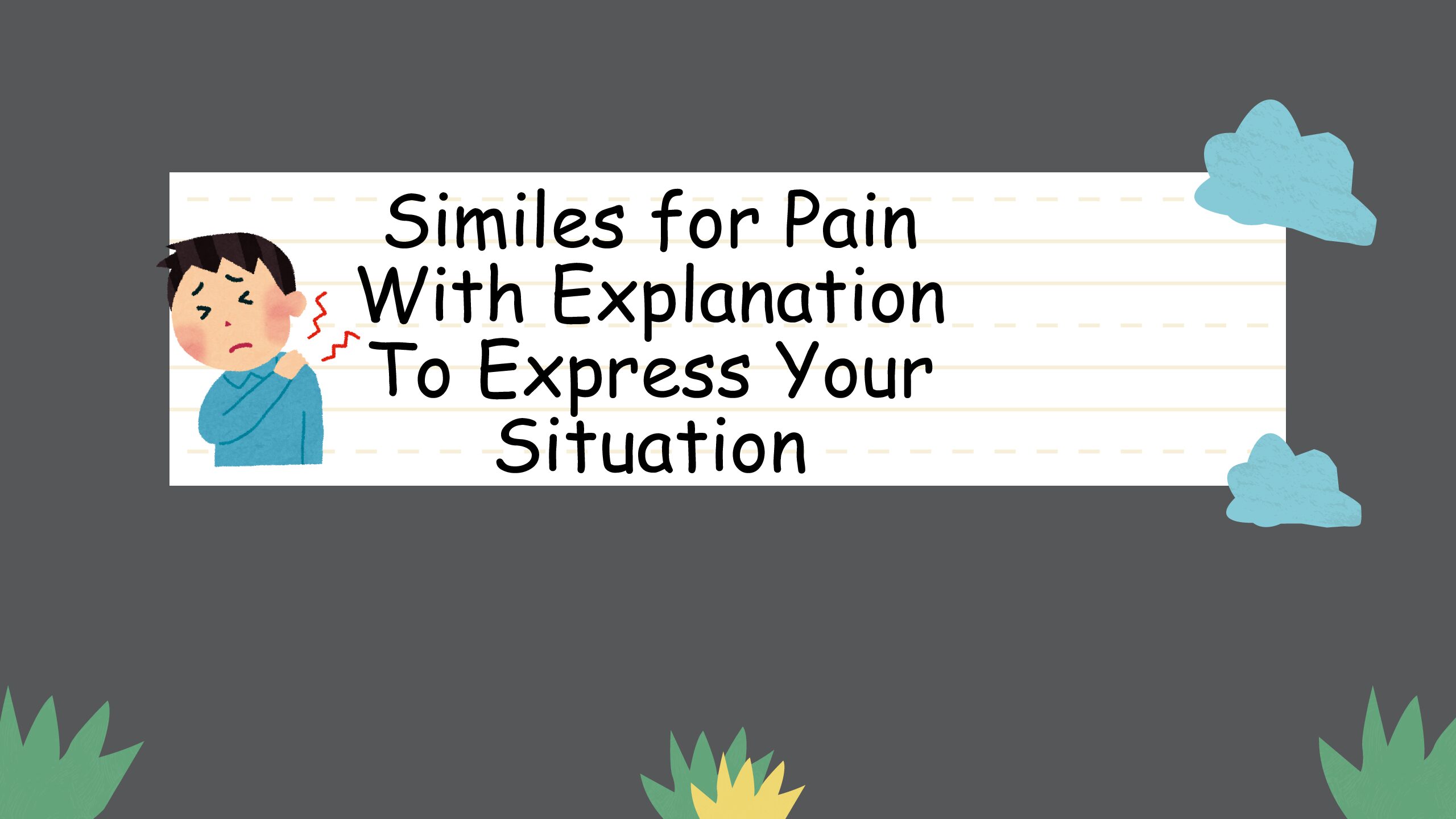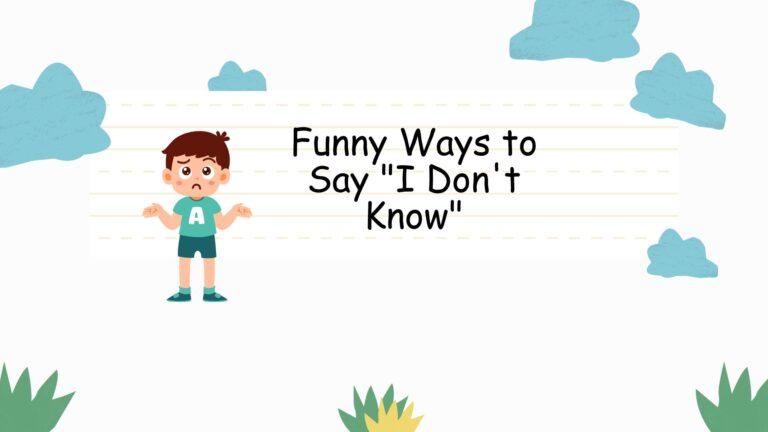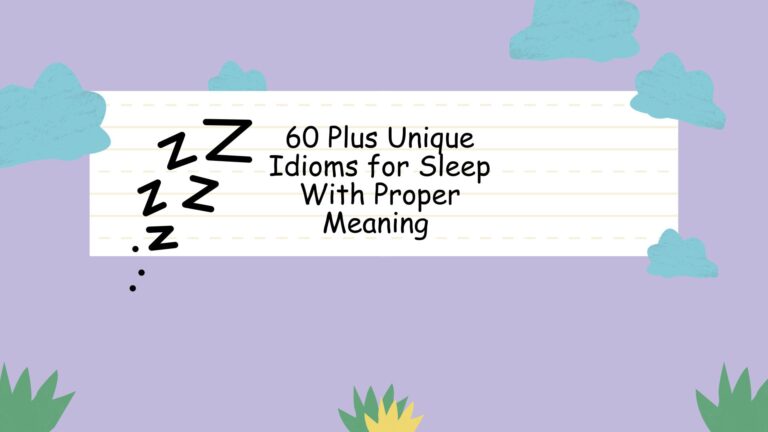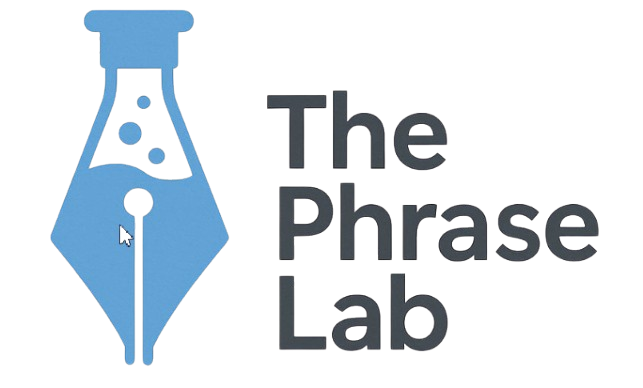
45 Plus Similies For Lost in the Woods: Meaning and More
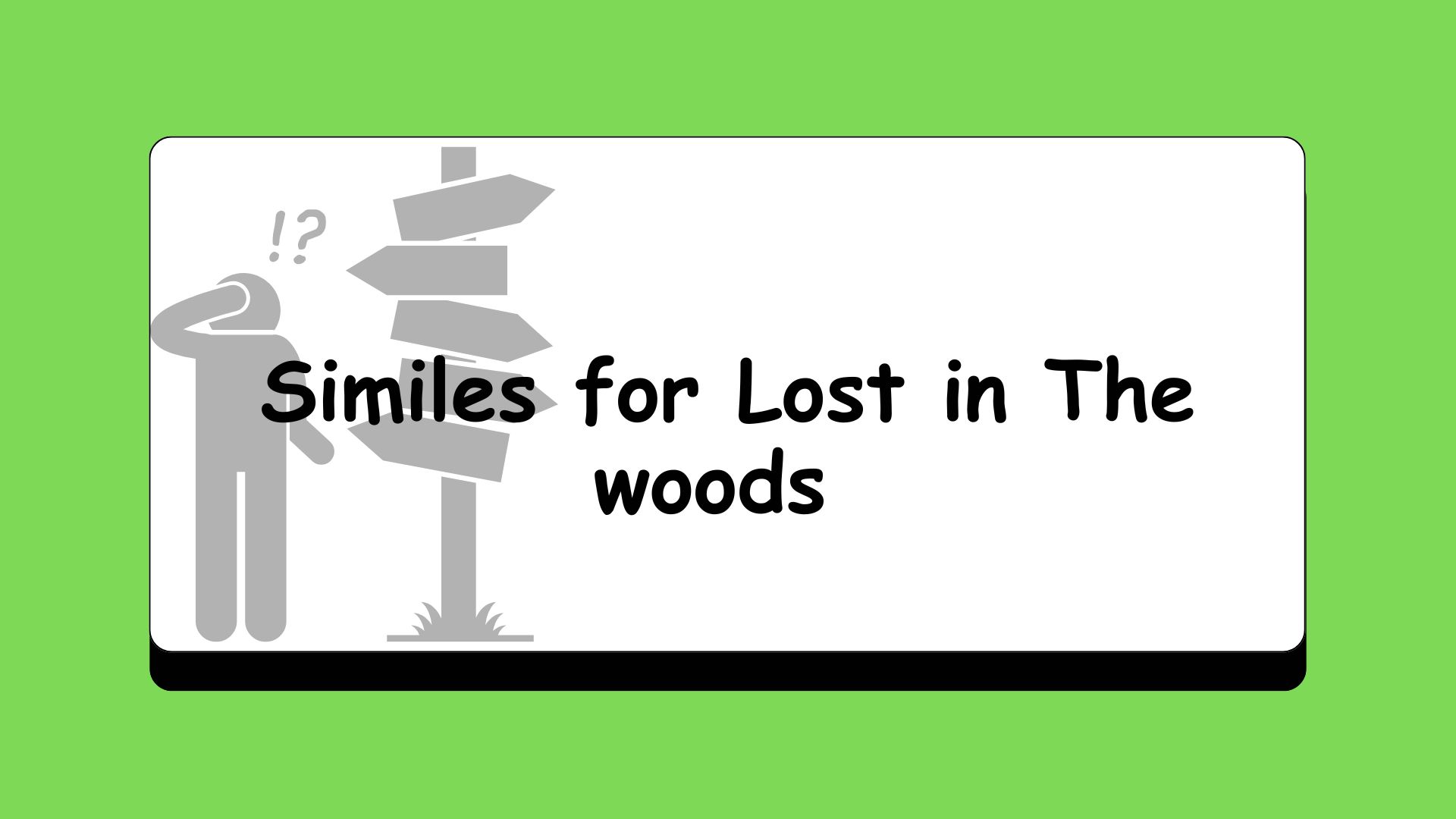
Confusion is a universal human experience, and English offers a rich tapestry of similes to describe its nuances. Understanding these similes not only enhances your vocabulary but also allows you to express yourself more vividly and accurately. This article delves into the world of similes that depict confusion, exploring their meanings, usage, and structural elements. Whether you’re an ESL student, a writer seeking to add flair to your prose, or simply someone curious about the English language, this guide will equip you with the knowledge to navigate the often-muddled terrain of confusion with confidence.
We will explore the various ways confusion can be expressed through similes, breaking down common structures, providing numerous examples, and offering practical exercises to solidify your understanding. By the end of this article, you’ll be able to recognize, interpret, and effectively use similes for confusion in both your writing and speech. Let’s learn the similies ofr lost in the woods.
Table of Contents
- Defining Similes for Confusion
- Structural Breakdown of Confusion Similes
- Types of Confusion Similes
- Examples of Similes for Confusion
- Usage Rules for Confusion Similes
- Common Mistakes with Confusion Similes
- Practice Exercises
- Advanced Topics: Nuances and Variations
- Frequently Asked Questions
- Conclusion
Defining Similes for Confusion
A simile is a figure of speech that compares two unlike things using the words “like” or “as.” Similes for confusion, therefore, draw parallels between the state of being confused and something else that embodies that state. These similes are powerful tools for conveying the intensity and specific nature of confusion, making your language more descriptive and engaging.
The primary function of a simile for confusion is to provide a relatable and vivid image of a mental state that can be difficult to articulate directly. Rather than simply stating “I was confused,” a simile allows you to express the depth and quality of that confusion, painting a picture in the reader’s mind. Similes can be used in various contexts, from everyday conversations to formal writing, adding depth and color to your expressions.
Similes are classified as a type of figurative language, specifically a type of comparison. They differ from metaphors, which directly equate two unlike things (e.g., “He *is* a lion”). Similes maintain a distinction between the two things being compared, using “like” or “as” to signal the comparison (e.g., “He fights *like* a lion”). This distinction is crucial in understanding and using similes effectively.
Structural Breakdown of Confusion Similes
The basic structure of a simile is quite simple: A + like/as + B, where A is the subject being described and B is the object used for comparison. In the context of confusion similes, A represents the person or situation experiencing confusion, and B represents something that is inherently confusing or chaotic.
Let’s break down the components:
- Subject (A): The person, place, or thing experiencing confusion. Examples: “I,” “The student,” “The instructions.”
- Comparison Word (like/as): The word that establishes the comparison. While “like” and “as” are the most common, variations such as “similar to” or “resembles” can sometimes be used to create a simile, though these are less frequent.
- Object of Comparison (B): The thing that is being used to describe the state of confusion. This could be anything from a tangled mess to a dense fog. Examples: “a maze,” “a thick fog,” “a scrambled egg.”
Consider the simile, “He was as lost as a sheep in the woods.” Here:
- “He” is the subject (A).
- “as” is the comparison word.
- “a sheep in the woods” is the object of comparison (B).
The effectiveness of a simile depends on the strength of the connection between A and B. The more relatable and vivid the object of comparison, the more impactful the simile will be.
Types of Confusion Similes
Similes for confusion can be categorized based on the specific type of confusion they describe. Here are some common categories:
General Confusion
These similes describe a broad sense of being mixed up or disoriented, without specifying the cause or nature of the confusion.
Mental Fog
These similes evoke a sense of mental cloudiness, difficulty thinking clearly, or a lack of focus.
Disorientation
These similes focus on a feeling of being lost, either physically or mentally, and not knowing which way to turn.
Perplexity
These similes emphasize the puzzling and baffling nature of confusion, suggesting that something is difficult to understand.
Bewilderment
These similes convey a stronger sense of disorientation and astonishment, often implying that the confusion is caused by something unexpected or shocking.
Examples of Similes for Confusion
This section provides extensive examples of similes for confusion, organized by the categories discussed above. Each table contains a variety of similes to illustrate the different ways you can express confusion using figurative language.
General Confusion
These similes capture a general sense of being mixed up or unclear about something. They are suitable for situations where the specific nature of the confusion is less important than the overall feeling of being bewildered.
The following table illustrates similes that describe general confusion:
| Simile | Explanation |
|---|---|
| He looked like a deer in headlights. | Describes someone startled and confused, unable to react. |
| I felt like I was walking through a maze. | Suggests feeling lost and unsure of the correct path. |
| She was as confused as a chameleon in a bag of Skittles. | A humorous simile emphasizing the inability to adapt or understand. |
| The instructions were like a foreign language to me. | Implies that the instructions were incomprehensible. |
| He was as lost as a ball in high weeds. | Describes someone who is completely and utterly lost. |
| I felt like I was trying to solve a Rubik’s Cube blindfolded. | Indicates a complex and seemingly impossible task. |
| She looked as bewildered as a baby bird in a snowstorm. | Suggests helplessness and confusion in the face of overwhelming circumstances. |
| The situation was as clear as mud. | A common simile meaning the situation was not clear at all. |
| He was like a fish out of water. | Describes someone in an unfamiliar and uncomfortable situation. |
| I felt like I had stepped into an alternate reality. | Indicates a sense of disbelief and disorientation. |
| She was as mixed up as a milkshake. | A playful simile suggesting a state of complete disarray. |
| He looked like he was trying to herd cats. | Describes someone attempting to manage a chaotic and uncontrollable situation. |
| I felt like I was drowning in information. | Indicates being overwhelmed by too much data. |
| She was as perplexed as a puppy trying to understand quantum physics. | A humorous simile highlighting the impossibility of understanding. |
| He was like a ship without a rudder. | Suggests a lack of direction and control. |
| I felt like I was trapped in a dream. | Indicates a sense of unreality and confusion. |
| She was as baffled as a baker without bread. | A whimsical simile emphasizing a lack of essential resources. |
| He looked like he had seen a ghost. | Describes someone who is shocked and disoriented. |
| I felt like I was going in circles. | Indicates a lack of progress and a sense of repetition. |
| She was as disoriented as a compass in a magnetic field. | Suggests being unable to find one’s bearings. |
| He was like a blind man searching for a black cat in a dark room. | Implies an impossible and futile task. |
| I felt like I was lost in translation. | Indicates a misunderstanding due to language or cultural barriers. |
| She was as muddled as a pot of stew. | Suggests a state of confusion and disorder. |
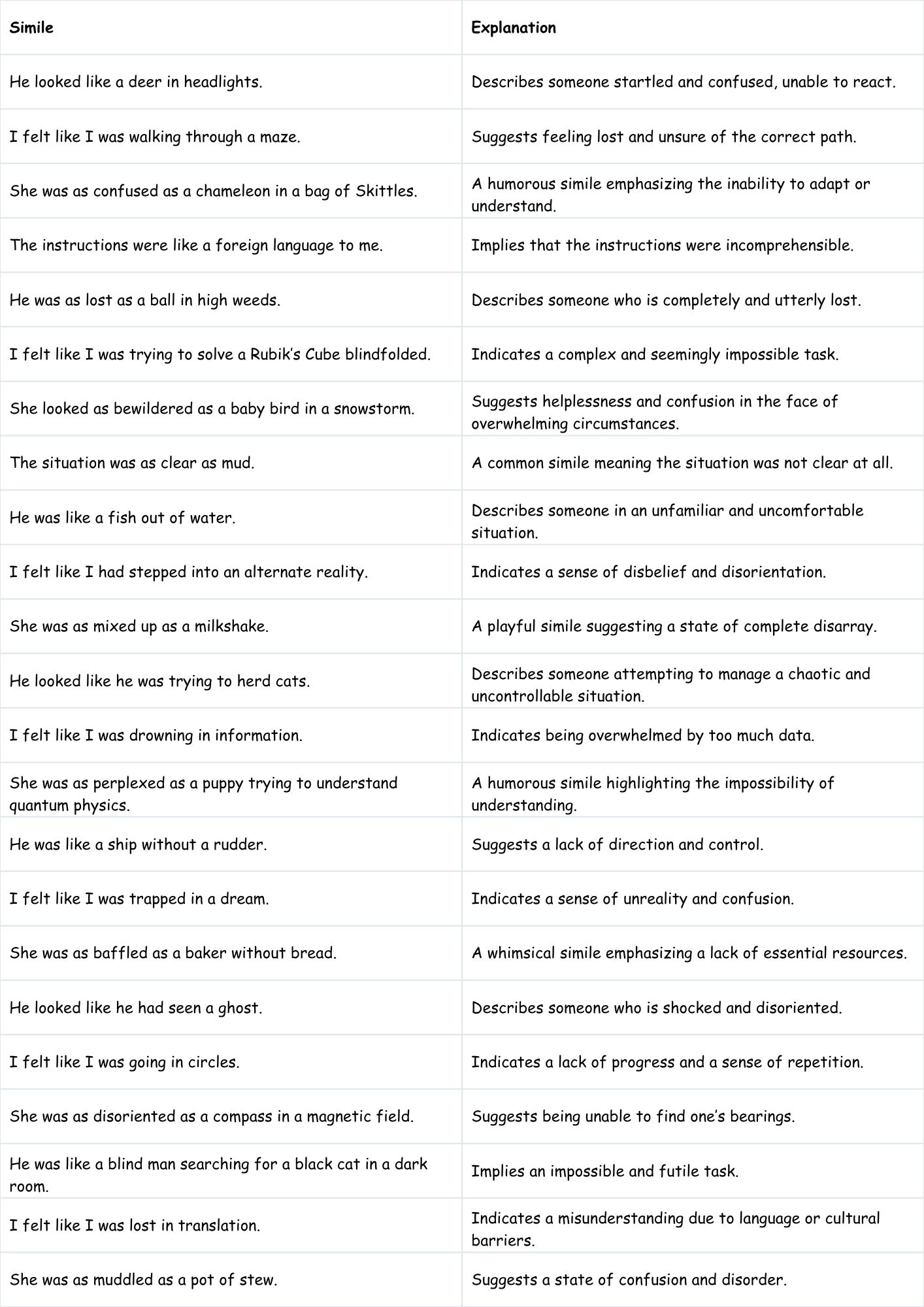
Mental Fog
These similes describe a state of mental cloudiness or difficulty thinking clearly. They are useful for conveying a sense of disorientation and lack of focus.
The following table illustrates similes that describe mental fog:
| Simile | Explanation |
|---|---|
| My mind felt like a bowl of cotton. | Indicates a soft, fuzzy, and unclear mental state. |
| His thoughts were as tangled as a ball of yarn. | Suggests confused and disorganized thinking. |
| My brain felt like it was full of static. | Implies a noisy and unclear mental state. |
| Her mind was like a cloudy day. | Describes a lack of mental clarity and brightness. |
| His thoughts were as hazy as a summer morning. | Suggests a vague and indistinct mental state. |
| My memory was like a broken record. | Indicates a repetitive and unreliable memory. |
| Her brain felt like it was running on low battery. | Describes a lack of mental energy and focus. |
| His mind was as blank as a white canvas. | Suggests an inability to think or remember anything. |
| My thoughts were as jumbled as a deck of cards after shuffling. | Indicates disorganized and chaotic thinking. |
| Her brain felt like it was stuck in molasses. | Describes a slow and sluggish mental state. |
| His mind was as foggy as a London street in winter. | Suggests a dense and impenetrable mental state. |
| My thoughts were like scattered leaves in the wind. | Indicates a lack of focus and direction. |
| Her brain felt like it was full of cobwebs. | Describes a neglected and unclear mental state. |
| His mind was as murky as a swamp. | Suggests a dark and unclear mental state. |
| My thoughts were like whispers in a hurricane. | Indicates being overwhelmed and unable to hear one’s own thoughts. |
| Her brain felt like it was wrapped in cotton wool. | Describes a muffled and unclear mental state. |
| His mind was as cluttered as an attic. | Suggests a disorganized and overwhelming mental state. |
| My thoughts were like puzzle pieces that didn’t fit. | Indicates a lack of coherence and understanding. |
| Her brain felt like it was on pause. | Describes a temporary inability to think or remember. |
| His mind was as clouded as a dirty window. | Suggests a distorted and unclear mental state. |
| My thoughts were like a tangled fishing line. | Indicates a confused and frustrating mental state. |
| Her brain felt like it had short-circuited. | Describes a temporary mental breakdown. |
| His mind was as dense as a brick wall. | Suggests an inability to understand or process information. |
Disorientation
These similes focus on the feeling of being lost or unsure of one’s bearings, either physically or mentally. They are useful for describing situations where someone feels directionless or confused about their surroundings.
The following table illustrates similes that describe disorientation:
| Simile | Explanation |
|---|---|
| I felt like I was wandering in a desert. | Indicates a sense of isolation and lack of direction. |
| He was as lost as a needle in a haystack. | Suggests being hopelessly lost and difficult to find. |
| I felt like I was spinning in circles. | Indicates a lack of progress and a sense of confusion. |
| She was as disoriented as a compass in the Bermuda Triangle. | Suggests being unable to find one’s bearings in a mysterious and confusing place. |
| He felt like he was adrift at sea. | Indicates a lack of direction and control. |
| I was as turned around as a top. | Suggests being physically and mentally disoriented. |
| She felt like she was in a hall of mirrors. | Describes a confusing and distorted sense of reality. |
| He was as lost as a tourist in Tokyo. | Suggests being overwhelmed by an unfamiliar environment. |
| I felt like I was in a maze of twisty little passages, all alike. | Indicates a confusing and repetitive environment. |
| She was as disoriented as a bat in daylight. | Suggests being out of one’s element and unable to navigate. |
| He felt like he was walking on quicksand. | Indicates a sense of instability and uncertainty. |
| I was as turned around as a politician’s promises. | Suggests being misled and confused by contradictory statements. |
| She felt like she was in a dream within a dream. | Describes a confusing and layered sense of unreality. |
| He was as lost as a soul without a map. | Suggests a lack of purpose and direction in life. |
| I felt like I was in a labyrinth. | Indicates a complex and confusing environment. |
| She was as disoriented as an astronaut returning to Earth. | Suggests a sudden and overwhelming change in perspective. |
| He felt like he was wandering through a fog-shrouded forest. | Indicates a sense of mystery and uncertainty. |
| I was as turned around as a dancer without music. | Suggests a lack of guidance and rhythm. |
| She felt like she was in a kaleidoscope. | Describes a constantly shifting and confusing pattern. |
| He was as lost as a whisper in a crowd. | Suggests being overwhelmed and unable to be heard or understood. |
| I felt like I was walking a tightrope without a net. | Indicates a sense of risk and uncertainty. |
| She was as disoriented as a time traveler in the wrong century. | Suggests being out of place and time. |
| He felt like he was trapped in a revolving door. | Indicates a futile and repetitive situation. |
Perplexity
These similes emphasize the puzzling and baffling nature of confusion, suggesting that something is difficult to understand or explain. They are useful for describing situations where someone is faced with a complex or inexplicable problem.
The following table illustrates similes that describe perplexity:
| Simile | Explanation |
|---|---|
| The problem was like a riddle wrapped in an enigma. | Indicates a complex and mysterious puzzle. |
| He was as puzzled as a cat with a computer. | Suggests a lack of understanding and familiarity. |
| The situation was as perplexing as a paradox. | Indicates a contradictory and confusing statement. |
| She was as baffled as a scientist with a supernatural phenomenon. | Suggests being faced with something inexplicable. |
| The question was like a Gordian knot. | Indicates a complex and seemingly unsolvable problem. |
| He was as stumped as a detective with no clues. | Suggests being unable to find a solution or explanation. |
| The explanation was as convoluted as a politician’s answer. | Indicates a confusing and evasive response. |
| She was as perplexed as a linguist with an unknown language. | Suggests being unable to understand due to a lack of knowledge. |
| The mystery was like a Russian nesting doll. | Indicates a series of nested and interconnected puzzles. |
| He was as puzzled as a bird trying to understand calculus. | Suggests a complete lack of comprehension. |
| The situation was as enigmatic as the Mona Lisa’s smile. | Indicates a mysterious and ambiguous quality. |
| She was as baffled as an engineer with an alien device. | Suggests being faced with something completely unfamiliar. |
| The problem was like a Chinese finger trap. | Indicates a situation where the more you struggle, the worse it gets. |
| He was as stumped as a chess player facing an impossible checkmate. | Suggests being in a hopeless situation. |
| The explanation was as circular as a Mobius strip. | Indicates a self-referential and confusing argument. |
| She was as perplexed as a historian with a time paradox. | Suggests being faced with a contradiction in the fabric of time. |
| The mystery was like a locked room with no key. | Indicates a seemingly impossible crime or puzzle. |
| He was as puzzled as an owl in a disco. | Suggests being out of place and unable to understand the environment. |
| The situation was as cryptic as an ancient scroll. | Indicates a hidden and difficult-to-decipher meaning. |
| She was as baffled as a philosopher with the meaning of life. | Suggests being faced with an unanswerable question. |
| The problem was like a house of cards. | Indicates a fragile and easily collapsed structure. |
| He was as stumped as a magician trying to explain his tricks. | Suggests being unable to reveal the inner workings of something. |
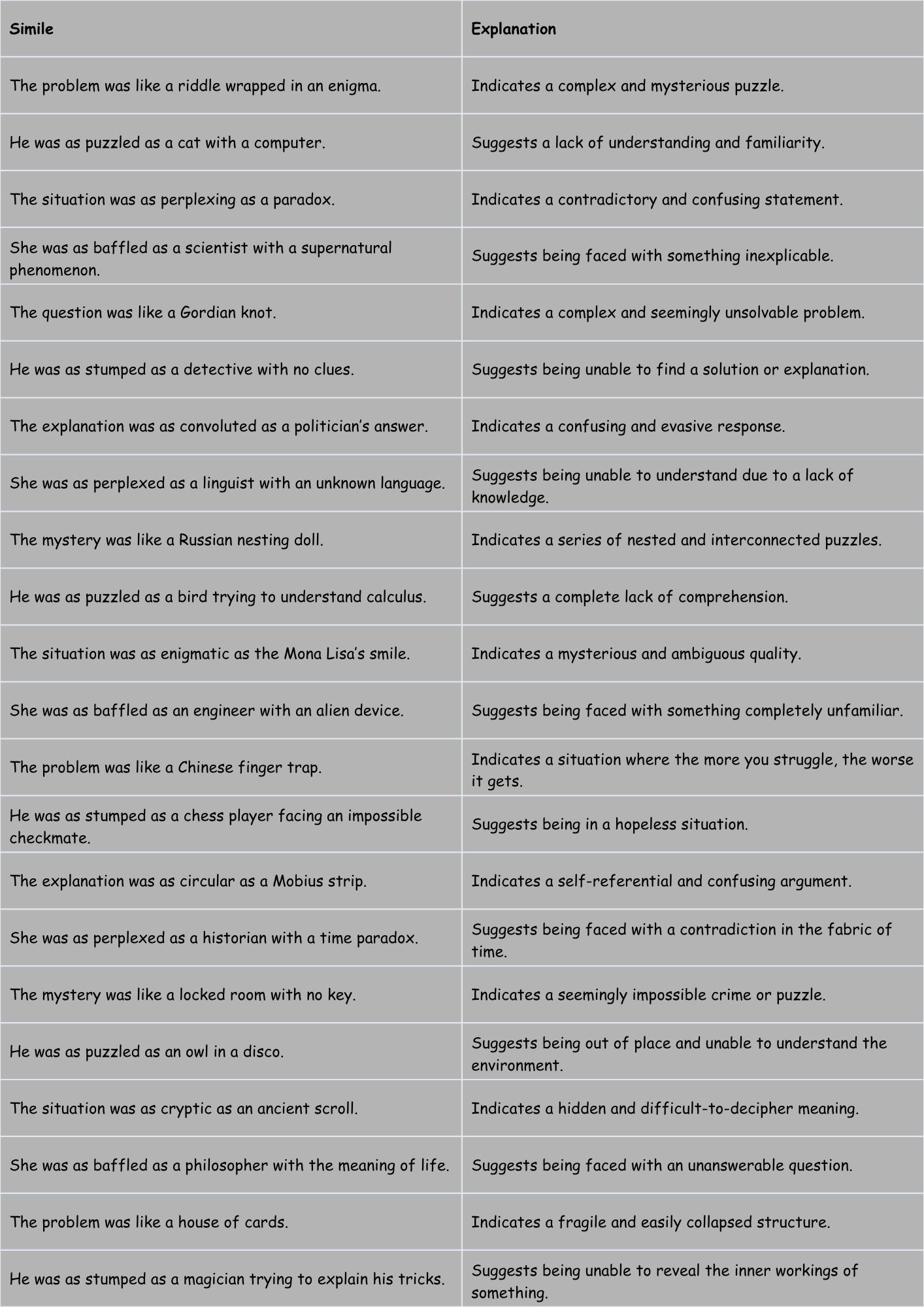
Bewilderment
These similes convey a stronger sense of disorientation and astonishment, often implying that the confusion is caused by something unexpected or shocking. They are useful for describing situations where someone is completely taken aback and unsure of what to do.
The following table illustrates similes that describe bewilderment:
| Simile | Explanation |
|---|---|
| He was as bewildered as a rabbit caught in a snare. | Suggests being trapped and confused by an unexpected situation. |
| She was as astonished as if she’d seen a unicorn. | Indicates a sense of disbelief and wonder. |
| He was as taken aback as if he’d been struck by lightning. | Suggests a sudden and shocking surprise. |
| She was as dumfounded as if the sky had fallen. | Indicates a sense of overwhelming shock and confusion. |
| He was as flabbergasted as if he’d won the lottery. | Suggests a sense of extreme surprise and disbelief. |
| She was as bewildered as if she’d woken up on Mars. | Indicates a sense of being in a completely unfamiliar environment. |
| He was as astonished as if he’d seen a ghost. | Suggests a sense of fear and disbelief. |
| She was as taken aback as if she’d been slapped in the face. | Indicates a sudden and unpleasant surprise. |
| He was as dumfounded as if he’d discovered the Earth was flat. | Suggests a sense of disbelief in something previously taken for granted. |
| She was as flabbergasted as if she’d found a million dollars. | Suggests a sense of extreme good fortune and surprise. |
| He was as bewildered as a time traveler in the present day. | Suggests being out of sync with the current world. |
| She was as astonished as if she’d seen a talking dog. | Indicates a sense of amusement and disbelief. |
| He was as taken aback as if he’d been betrayed by a close friend. | Suggests a sense of deep disappointment and surprise. |
| She was as dumfounded as if she’d learned she was adopted. | Indicates a life-altering revelation. |
| He was as flabbergasted as if he’d been offered a job as an astronaut. | Suggests an unexpected and exciting opportunity. |
| She was as bewildered as a newborn calf on a frozen pond. | Suggests helplessness and confusion in a dangerous situation. |
| He was as astonished as if he’d met his doppelganger. | Indicates a sense of uncanny resemblance and disbelief. |
| She was as taken aback as if she’d been caught in a sudden storm. | Suggests being overwhelmed by unexpected circumstances. |
| He was as dumfounded as if he’d discovered a new planet. | Indicates a groundbreaking and surprising discovery. |
| She was as flabbergasted as if she’d been crowned queen. | Suggests an unexpected and prestigious honor. |
Usage Rules for Confusion Similes
Using similes effectively requires understanding a few key rules:
- Clarity: The object of comparison (B) should be something that the audience can easily understand and relate to. A simile is ineffective if the comparison itself is confusing.
- Relevance: The comparison should be relevant to the aspect of confusion you’re trying to emphasize. Choose an object of comparison that highlights the specific quality of confusion you want to convey.
- Originality: While common similes can be effective, striving for originality can make your writing more engaging and memorable. Avoid clichés and try to find fresh and creative comparisons.
- Context: Consider the context in which you’re using the simile. A simile that works well in a humorous setting might be inappropriate in a serious one.
- Consistency: Ensure that the simile is consistent with the overall tone and style of your writing. A jarring or out-of-place simile can disrupt the flow and detract from your message.
Exceptions and Special Cases:
While “like” and “as” are the most common comparison words, other words or phrases can sometimes be used to create similes, such as “similar to,” “resembles,” or “in the same way as.” However, these are less common and should be used sparingly to avoid confusion.
In some cases, a simile may be implied rather than explicitly stated. For example, you might say “His mind was a tangled web,” implying the comparison without using “like” or “as.” However, this is closer to a metaphor and should be used with caution.
Common Mistakes with Confusion Similes
Even experienced writers can make mistakes when using similes. Here are some common errors to avoid:
| Incorrect | Correct | Explanation |
|---|---|---|
| He was confused like a car. | He was confused like a driver without a map. | The object of comparison should be something that can experience confusion. |
| She was as confused as happy. | She was as confused as someone trying to read a map upside down. | The object of comparison should evoke a sense of confusion. |
| The instructions were like. | The instructions were like a jigsaw puzzle with missing pieces. | The simile is incomplete; it lacks the object of comparison. |
| He was as confused as the color blue. | He was as confused as someone trying to navigate a city without street signs. | The object of comparison should be relatable and relevant to confusion. |
| She was confused as a fish. | She was as confused as a fish out of water. | The comparison needs further context to effectively convey confusion. |
It’s also important to avoid using clichés or overused similes. While they may be easy to come up with, they often lack impact and can make your writing seem unoriginal. Try to find fresh and creative comparisons that will capture the reader’s attention.
Practice Exercises
Test your understanding of similes for confusion with these practice exercises.
Exercise 1: Identify the Simile
Identify the simile in each sentence and explain what type of confusion it describes (general, mental fog, disorientation, perplexity, or bewilderment).
| Question | Answer |
|---|---|
| 1. He felt like he was walking through a dense fog. | Simile: “like he was walking through a dense fog.” Type: Mental Fog |
| 2. She was as perplexed as a student facing a complex equation. | Simile: “as perplexed as a student facing a complex equation.” Type: Perplexity |
| 3. He was as lost as a sheep in the woods. | Simile: “as lost as a sheep in the woods.” Type: Disorientation |
| 4. I felt like my brain was full of cotton. | Simile: “like my brain was full of cotton.” Type: Mental Fog |
| 5. She was as bewildered as someone who had just woken up from a coma. | Simile: “as bewildered as someone who had just woken up from a coma.” Type: Bewilderment |
| 6. The instructions were like a foreign language to him. | Simile: “like a foreign language to him.” Type: General Confusion |
| 7. He was as confused as a chameleon in a bag of Skittles. | Simile: “as confused as a chameleon in a bag of Skittles.” Type: General Confusion |
| 8. I felt like I was trapped in a maze. | Simile: “like I was trapped in a maze.” Type: Disorientation |
| 9. She was as baffled as a scientist with a magic trick. | Simile: “as baffled as a scientist with a magic trick.” Type: Perplexity |
| 10. He was as disoriented as a compass in a magnetic field. | Simile: “as disoriented as a compass in a magnetic field.” Type: Disorientation |
Exercise 2: Complete the Simile
Complete the following similes to describe confusion.
| Question | Answer |
|---|---|
| 1. He was as confused as a _______. | He was as confused as a tourist without a map. |
| 2. She felt like her mind was _______. | She felt like her mind was a tangled ball of yarn. |
| 3. The instructions were like _______ . | The instructions were like a cryptic code. |
| 4. He was as disoriented as _______ . | He was as disoriented as a bat in daylight. |
| 5. She was as bewildered as _______ . | She was as bewildered as a child lost in a department store. |
| 6. I felt like I was _______ . | I felt like I was drowning in information. |
| 7. He was as perplexed as _______ . | He was as perplexed as a student facing an impossible exam. |
| 8. She was as lost as _______ . | She was as lost as a needle in a haystack. |
| 9. The situation was as clear as _______ . | The situation was as clear as mud. |
| 10. He felt like he was _______ . | He felt like he was walking through quicksand. |
Exercise 3: Write Your Own Similes
Write your own similes to describe the following situations:
- Trying to understand a complex scientific theory.
- Being lost in a foreign city.
- Waking up from a confusing dream.
- Reading a poorly written instruction manual.
- Listening to a politician’s speech.
Possible Answers:
- Trying to understand a complex scientific theory: It was like trying to assemble a puzzle with pieces from different boxes.
- Being lost in a foreign city: I felt like a ship without a sail, tossed about by unfamiliar currents.
- Waking up from a confusing dream: My mind was as muddled as a shaken snow globe.
- Reading a poorly written instruction manual: The instructions were like a labyrinth of words, leading nowhere.
- Listening to a politician’s speech: His words were as slippery as eels, impossible to grasp.
Advanced Topics: Nuances and Variations
For advanced learners, it’s important to understand the subtle nuances and variations in similes for confusion. This includes recognizing the impact of different word choices, understanding the cultural context of similes, and being able to create original and impactful comparisons.
For example, consider the difference between “He was as confused as a child” and “He was as confused as a seasoned detective facing a cold case.” The first simile suggests a simple lack of understanding, while the second implies a more complex and frustrating type of confusion.
Additionally, some similes may be more culturally specific than others. For example, a simile that references a specific cultural event or figure may not be easily understood by someone from a different background.
Finally, the most advanced skill is the ability to create original and impactful similes that capture the specific nuances of confusion in a unique and memorable way. This requires a deep understanding of language, a keen eye for observation, and a willingness to experiment with different comparisons.
Frequently Asked Questions
Here are some frequently asked questions about similes for confusion:
- What is the difference between a simile and a metaphor?A simile compares two unlike things using “like” or “as,” while a metaphor directly equates them. For example, “He is like a lion” (simile) vs. “He is a lion” (metaphor).
- Can I use similes in formal writing?Yes, similes can be used in formal writing, but they should be used sparingly and with careful consideration of the context and audience. Avoid clichés and strive for originality.
- How can I make my similes more effective?Choose objects of comparison
that are relatable, vivid, and relevant to the aspect of confusion you want to emphasize. Strive for originality and avoid clichés. - Are there any situations where I should avoid using similes?In highly technical or scientific writing, similes may be inappropriate if they introduce ambiguity or lack precision. In such cases, it’s best to use direct and literal language.
- Can I use similes in spoken language?Yes, similes can be used effectively in spoken language to add color and emphasis to your expressions. However, be mindful of your audience and avoid using similes that may be confusing or offensive.
Conclusion
Similes are powerful tools for expressing the multifaceted nature of confusion. By understanding the structure, types, and usage rules of similes, you can effectively use them to enhance your writing and speech. Whether you’re describing a general sense of bewilderment, a mental fog, or a state of disorientation, similes can help you paint a vivid picture in the reader’s mind and convey the depth and complexity of the human experience of confusion. So, embrace the power of figurative language and let your creativity flow as you explore the world of similes for confusion.

